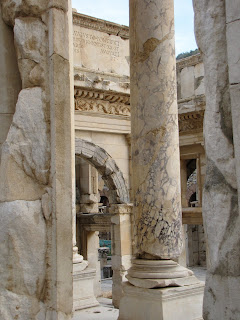
After 14 months abroad I was excited to return home to the states; but anxious, terrified, hesitant, and confused all at the same time. Checking in for a US-bound flight didn't go as smoothly as my previous flights for which I was equally annoyed and thankful. After demanding our passports without so much as a polite greeting, the United employee grilled us on our whereabouts and intentions...
Him: How long have you been out of the U.S.?
Me: 14 months
Him: Where were you before Istanbul?
Me: Umm... South Korea, China, Japan, Thailand, Jordan, and Egypt.
Him: Have you been to Tel Aviv?
Me: No.
He walks away with my passport and then returns.
Him: Are you sure you haven't been to Tel Aviv?
Me: Yes (Of course I'm sure!—I think I'd remember that!)
Him: furrowed brow
Just then, a light bulb turned on in my head as I realized I had an Israeli stamp from the border crossing between Jordan and Egypt. I explained the stamp and then all was well. Still, what if I had been to Tel Aviv? What would have happened to me? No Thanksgiving dinner?
The flight into Chicago was delayed several hours and as Melissa and I sat in our seats worrying whether or not we would make our connecting flights back home, we concocted an emergency Thanksgiving dinner plan. If we were put up in a hotel for the night we were going to make sure we had the culinary items most important in any Thanksgiving spread: Oreos, Dr. Pepper, some kind of cheese, Chai lattes, etc.
Luckily, Melissa made her connecting flight which had been delayed, as well. I, however, did not. After transferring to the next flight out, which was delayed for mechanical problems; attempting unsuccessfully to hop on stand-by with a separate flight a few hours later; and then returning to the gate in order to wait for the mechanical-problem-plane to show up I finally arrived home at 1:00 am on Thanksgiving day—six hours late. As many problems as I had, poor Andrea had more and ended up staying a night in Frankfurt, Germany. Fourteen months out of the country and we could barely catch a break back into our own states. But, I survived the ordeal and the days, weeks, and months away from home and returned home to my first American meal filled with turkey, mashed potatoes, spinach casserole, and pumpkin pie. Not bad.
Things I noticed immediately upon returning to the U.S.A (before leaving the airport)....
1. Everyone speaks English and it's very distracting. After living among foreign languages so long it was difficult to tune out the conversations around me, especially while still in the airport. Several people were discussing their trips home from college, one girl was crying about the possibility of missing Thanksgiving and spending it alone in the airport but didn't feel her boyfriend was sympathizing enough with the situation, and a family debated whether it would be faster to drive from Chicago rather than wait on the late flight. I wasn't even deliberately eavesdropping!
2. Trash cans. They're everywhere!
3. Toilet paper. It's everywhere!
4. American money doesn't need to be converted in my head.
5. The menus at each restaurant and food stand throughout the airport are in English.


































